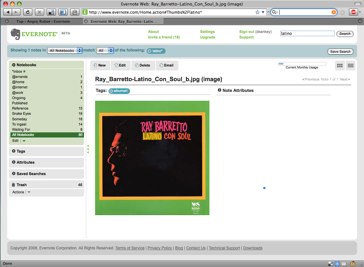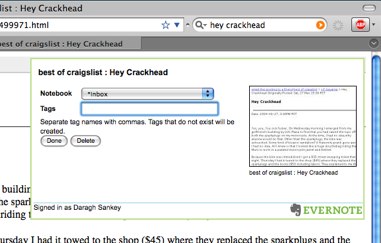Evernote
I’ve been giving Evernote a run through. So far, it’s an excellent app/service for those multi-platform types looking to organize themselves.
What is it?
Evernote’s tagline is “remember everything.” It says of itself:
Evernote allows you to easily capture information in any environment using whatever device or platform you find most convenient, and makes this information accessible and searchable at any time, from anywhere.
If you’re looking to implement an organizational system and you’re largely glued to a single computer, there are many choices for you. If, however, you find yourself on different computers or often away from them altogether, your choices are much more limited. That’s where our homeboy Evernizzle steps in. Evernote offers Mac and Windows desktop clients, a mobile web interface, an iPhone-specific interface, and a regular web app, all of which sync with each other. You can also email things to Evernote and it will make notes for them.

Evernote’s mac client (click to enlarge)
As you might guess, evernote’s atomic element is the note, which can be a text file, a web clipping, an image, or a PDF. Notes can be organized into notebooks (folders) and tagged as you see fit. Once a note is synced to the web (which happens at intervals you select or when you hit the big synchronize button), the text is indexed and thus becomes searchable. One of the big ‘wow’ features is OCR, meaning that much text in images is also indexed.

The web interface finds text in images (click to enlarge)
Evernote’s strength is as a system for organizing reference material. With a cameraphone, the mobile interface and the OCR, you can be reasonably assured that any zany idea that comes into your head can be captured and later referenced. The web clipping feature, which can be used through a bookmarklet, automatically stores the URL and whatever text you have selected and is also quite handy. The folders and tagging pretty much let you organize shit in whatever way works for you.
How I’m using it
I am using Evernote for reference. I can’t say I’m using the mobile aspects or the OCR much, as my current phone and its camera are garbage. But when the Jesus Phone is made manifest here in a week or so, I’ll make use of Evernote’s dedicated iPhone interface. I do rock the web clipping quite a bit. For example, in a perfect world I maintain a list of movies I want to see that I can reference in the video store. If I web clip a review into evernote, I can have the entire review easily accessible, which is very helpful. The latest version of webclip is nice and pops up above the target page without forwarding you to a new page.

the new improved webclip (click for full shot)
I’m also trying to implement a GTD system, and I’m using Evernote for it. You can make check-offable lists in Evernote (in the mac client anyway), but I tend to make actions as whole notes, which can then be tagged with a project name and dragged into context notebooks. The disadvantage is the lack of an integrated calendar, or a system for syncing with other calendar software, but that hasn’t been a dealbreaker so far. I won’t really be able to tell how well the thing works until I have a proper mobile solution going, but in theory I should be pretty close to ubiquitous capture once that happens. THEN I WILL CONQUER THE WORLD!
The downsides
As Evernote is in beta, some of these will change. That said, these are the limitations of using it right now.
Allowance
The most significant sour note that Evernote hits is the monthly upload allowance. Once you have uploaded more than 40MB to the web service, your sync will be cut off for the rest of the month. And clearly, without sync, the system falls apart. There is now a for-pay premium service with a 500MB allowance for $5/month. As I mostly use text, I haven’t run up against the limits of the free version yet, and $5 a month is certainly a reasonable price, so this ain’t so bad.
Limited Export
Right now, the Windows app is the only interface that can actually export your data, which can either be saved as HTML or emailed to an address.
Inconsistent Interfaces
There are substantial UI and feature differences between the Mac, Windows, web and mobile interfaces. This is completely understandable when it comes to web and mobile, but is a little odd when it comes to the desktop apps. The explanation is that the windows app is much older, but it’s still strange to see features and whole view modes present in one app and not the other. I didn’t find this too much of a hangup, but it should probably be addressed at some point.
Limited Sharing
If you mostly work on projects that require collaboration, evernote won’t help you much. You can ‘publish’ a notebook so that it becomes viewable as a web page, but no one else can edit it or add to it. That said, this isn’t much of a criticism, as Evernote doesn’t bill itself as a tool for working collaboratively.
How it compares to Backpack
This comparison is somewhat arbitrary. There are many other web services in the same space as Evernote – Remember the Milk and Stikkit come to mind – but I’m not familiar with them. And Backpack’s current incarnation is as more of a modern-day Intranet than a PIM. However, there are still many legacy Backpack customers like myself who were using it as a web-accessible PIM, and who may be interested in Evernote.
Like Backpack, Evernote can be used to collect reference material by project and can also be used to organize tasks. Both allow content to be emailed into the system, and can store various different filetypes (although evernote doesn’t allow any file, as backpack does, and you store mp3s and such like at your peril, what with the upload limit). Both have web and mobile aspects.
Evernote’s biggest advantage over Backpack is robust desktop software. The Mac client is excellent, and while I’ve just started to use the Windows client, it seems full-featured (as it should, as it predates the Mac client by quite a while). The only backpack desktop apps are third party and cost money. And good luck getting sensible support out of 37 Signals.
Backpack has a built-in calendar and an integrated SMS reminder system, which Evernote lacks. However, if you’re like me you’ve dropped them for the superior Google Calendar, so you don’t really miss them.
Backpack’s biggest advantage is that it’s great for small teams. I keep expecting google apps to muscle in on some of the things backpack does, but it hasn’t happened yet. And it’s worth mentioning that 37 Signal’s patented Less is More™ approach makes for some excellent and intuitive interface design.
The part at the end in which shit be summarized
I’m very fond of Evernote. The combination of strong desktop apps and web and mobile interfaces is hard to beat. It’s an excellent way of organizing reference material, and it’s helping with the GTD as well. If you’re looking for something of this nature, I strongly suggest you take ‘er for a spin.